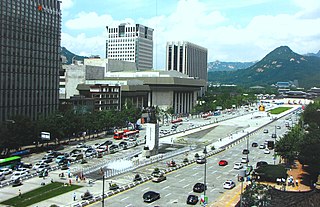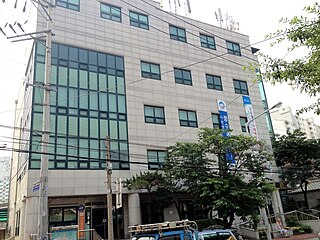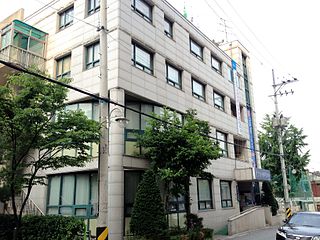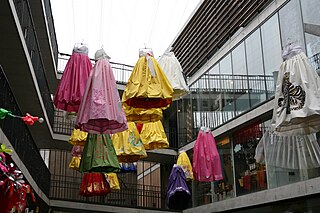
Dongdaemun History & Culture Park Station is a station on the Seoul Subway Line 2, Line 4 and Line 5. The huge Dongdaemun Market district is centered on this station and Dongdaemun Station, located to the north across Cheonggyecheon.

Seongdong District (Seongdong-gu) is one of the 25 gu which make up the city of Seoul, South Korea. It is situated on the north bank of the Han River. It is divided into 20 dong (neighbourhoods).

Jongno District is a district in central Seoul, South Korea. It takes its name from a major local street, Jongno, which means "Bell Road".

Dongdaemun District is one of the 25 districts of Seoul, South Korea.

Gwangjin District (Gwangjin-gu) is one of the 25 wards (gu) of Seoul, South Korea. It is located on the north bank of the Han River, to the eastern end of Seoul. It was created from neighboring Seongdong District in 1995.

Hoegi-dong is a dong, neighbourhood of Dongdaemun-gu in Seoul, South Korea.

Hwigyeong-dong is a neighbourhood, dong of Dongdaemun-gu in Seoul, South Korea.

Dapsimni-dong is a neighbourhood, dong of Dongdaemun-gu in Seoul, South Korea.

Imun-dong is a dong, neighbourhood of Dongdaemun-gu in Seoul, South Korea.

Jangan-dong is a dong (neighborhood) of Dongdaemun-gu in Seoul, South Korea.

Jeonnong-dong is a dong, neighbourhood of Dongdaemun-gu in Seoul, South Korea. It is home to the University of Seoul.
Sinseol-dong is a dong, legal neighbourhood of Dongdaemun-gu in Seoul, South Korea.

Changsin-dong is a dong, neighbourhood of Jongno-gu in Seoul, South Korea.

Gyeongdong Market or Kyungdong Market, located in Dongdaemun District, Seoul, is one of the largest herbal medicine and ginseng markets of South Korea. Since its establishment in 1960, the market supplies 70 percent of the nation's herbal medicine ingredients and has more than 1,000 related shops and oriental medicine clinics in the area. Gyeongdong Market also serves as a wholesale and retail markets selling agricultural products and fish in about 300,000 square meters, about five times the size of the Seoul Sangam World Cup Stadium.

Hwanghak-dong Flea Market is a market located in the neighborhood of Hwanghak-dong, Jung-gu, Seoul, South Korea to sell second-hand goods. It has over 500 shops and stalls near Dongdaemun Market supplying a wide range of used products such as electronic appliances, clothes, and other items. The market is also called Dokkaebi Market. It is located behind Samil Apartment and Cheonggyecheon.

Seoul, South Korea has many shopping areas and markets throughout the city, including Myeong-dong, Cheongdam-dong, Hongdae area, Dongdaemun and Namdaemun markets.

Dongdaemun Market or Tongdaemun is a large commercial district in Jongno-gu, Seoul, South Korea. With traditional markets and shopping centers, it is a popular shopping and tourist destination that has been designated a “Special Tourism Zone” (관광특구) since 2002.

Gwanghui-dong is a dong, neighbourhood of Jung-gu in Seoul, South Korea.

Gwangjang Market, previously Dongdaemun Market, is a traditional street market in Jongno-gu, Seoul, South Korea. The market is one of the oldest and largest traditional markets in South Korea, with more than 5000 shops and 20,000 employees in an area of 42,000 square metres. Approximately 65,000 people visit the market each day.
Retailing in South Korea consists of hypermarkets, department stores, flea markets, traditional markets, and underground shopping malls. Hypermarkets sell dry goods and groceries, similar to Western supercentres. Traditional markets are also popular throughout South Korea.




















